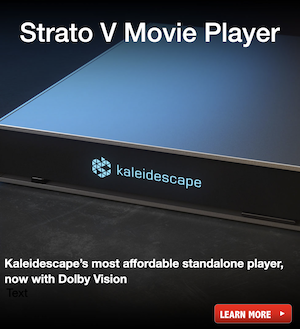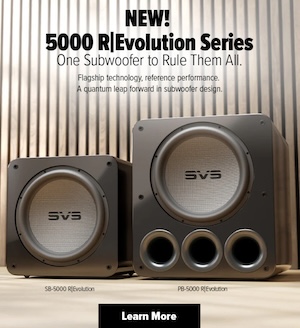(August 3, 2024) This year’s Value Electronics TV Shootout was a bit different than what we’ve experienced in the recent past. Most notably, it returned to its roots, shedding the swanky Company Building in Midtown Manhattan for the equally swanky surroundings of Scarsdale, NY and the cozy digs inside Value Electronics' own showroom.
Event creator and owner of Value Electronics, Robert Zohn, has officially run the TV Shootout for 20 years, though he told attendees he privately ran calibrated shootouts long before things were taken public. His goal then was to stay apprised of which TV model was the best top performer. Now, Zohn has trademarked the phrases “TV Shootout” and “King of TV” and says the event gives access to key data that buyers can use to pick the right TV for their particular use case.
Preparations for this year’s Shootout were extensive. Value Electronics' normally packed showroom was completely dismantled and cleared out to make room for a large gathering of media, judges, industry engineers and representatives, calibrators, and, of course, the subjects of the day: the TVs. Large swaths of blackout cloth and curtains were applied to windows, creating a generally darkened environment for scrutinizing reference content; that same cloth was easily opened for bright room portions of the evaluation. And, of course, each competing TV was professionally calibrated, placing it in its best operating state.
This year’s crop of TVs hailed from three major brands – Sony, LG, and Samsung – each crafting consumer-facing televisions using two types of displays. One grouping was OLED, while the other was miniLED LCD. Within those two categories, there’s a range of differences in both panel technologies and processing. In particular, Sony and Samsung OLEDs use Samsung Display’s advanced QD-OLED panels. LG, on the other hand, uses LG Display’s Micro Lens Array (MLA) panel, which was first introduced last year.
TVs competing in the OLED TV Shootout:
- LG OLED65G4PUA OLED TV (Buy on Amazon, Buy from Value Electronics)
- Samsung QN65S95D OLED TV (Buy on Amazon, Buy from Value Electronics)
- Sony XR65A95L OLED TV (Buy on Amazon, Buy from Value Electronics)
TVs competing in the MiniLED TV Shootout:
- LG 65QNED90T MiniLED TV (Buy on Amazon, Buy from Value Electronics)
- Samsung QN65QN95D MiniLED TV (Buy from Value Electronics)
- Sony K65XR90 Bravia 9 MiniLED TV (Buy on Amazon, Buy from Value Electronics)
If you’re going to hold an event geared to search for the best reference quality consumer TV, then you need a top-flight baseline monitor for comparison. This year’s reference point was Sony’s latest studio-grade 4K 30” BVM monitor, which is used in the vast majority of Hollywood post-production facilities. It carries model number Sony Professional BVM-HX3110 and costs a cool $20 grand. Two HX3110s were on hand; one was positioned near the OLED contestants, and the other was nested with the miniLED LCD models.
Judges painstakingly analyzed the TVs over a period of six hours, scoring across a range of performance categories using reference-grade media found on the Spears & Munsil Benchmark UHD disc and both movie and TV show content. Categories of performance included contrast, color fidelity, color saturation, and motion resolution for both standard dynamic range (SDR) and high dynamic range (HDR) material, with some non-reference material like sports broadcast on TV tossed in for good measure.
The event chose two winners, one for OLED and the other for miniLED, simply because there remains a noticeable divide between OLED and LCD performance. While Sony’s new K65XR90 Bravia 9 is a great LCD performer, it still can’t touch the elegant black-level performance offered by the best OLEDs on the market.
The Judges’ Take
If you’ve followed recent Shootout results, the winner of the 2024 TV Shootout will come as no surprise. Sony swept both miniLED and OLED categories, riding on the strength of its superior processing capabilities. The XR65A95L OLED had top scores for reference SDR content, general 4K video, extremely bright HDR video, and its ability to show streaming content. The Samsung QN65S95D OLED led the pack in both SDR content viewed with high ambient light and dark scenes with HDR.
The LG OLED65G4PUA performed great with SDR and general HDR content but struggled with both dark and bright HDR scenes.
Final, overall scoring had the Sony XR65A95L winning 8.9 to Samsung’s 8.8 and LG’s 8.4.
On the miniLED front, the Samsung QN65QN95D was judged to have the best performance when considering SDR video viewed in a bright room and HDR content within bright scenes. The Sony K65XR90 Bravia 9 netted top scores in the event's other four categories, ultimately landing a win with a final score of 8.1 (as compared to Samsung’s 8.0 and LG’s 7.3).
My Take and Purchase Recommendations
LG and its MLA OLED panel put up an admirable fight against Sony when considering SDR and general HDR performance. I was certainly impressed with its comparative performance to the reference BVM monitor, and had LG outpacing the Samsung OLED for much of the event. However, LG ultimately stumbled when it came to dark and bright scene HDR content. If it had performed better in those two categories, it may have slipped into second place.
Samsung, in my opinion, was the least impressive OLED competitor in SDR and real-world content. And while judges ultimately scored it just short of Sony’s XR65A95L, an anti-glare coating on the screen destroyed wide-angle viewing in a brightly lit room. Following the Shootout evaluation period, bright sunlight entered the room. From my vantage point, the Samsung’s coating radically impacted blacks and made the TV look like an older LCD TV (see image above; Samsung is upper right). For me, the anti-reflective coating's impact is a total deal breaker – I can’t imagine a scenario where I’d purchase the Samsung, especially if I were wanting sure-shot access to OLED's delicious black levels.
If cash is no object, Sony’s XR65A95L is the easy recommended pick. And for my money, if you primarily watch SDR content and want to save a few bucks, I’d roll with the LG OLED65G4PUA without hesitation.
On the miniLED LCD TV side of things, the Sony Bravia 9 was the far and away dominant performer. Its black-level performance is excellent, as is its ability to control blooming around bright objects over dark backgrounds. The Bravia 9 also delivers better shadow detail and natural-looking skin tones. If I were in the market for an LCD TV, it's the one I’d reach for.
I can’t say I was all that impressed with the Samsung QN65QN95D, but it easily outperformed LG’s 65QNED90T, which was the weakest performer of the lot. The LG’s black levels were elevated as compared to its competitors, colors weren’t as saturated, and shadow detail was middling.
So, for the day, Sony had a clean sweep and deservedly so. Both models stand as excellent options for the most discerning home theater enthusiasts.
Read a complete recap of Day Two of the 2024 Value Electronics TV Shootout, here.
Additional Reading:
- Day Two 2024 TV Shootout Report: TV Sizes Increase and Experts Vote on Best 'Out of the Box' Performance
- A Behind-the-Scenes Look at the Friendliest National Home Theater Retailer In the US: Value Electronics
- Value Electronics Crowns New Kings of 4K and 8K TVs at Its Annual Flatpanel Shootout Event!
- Value Electronics' Flatpanel Shootout Takes Place This Coming Weekend... New Kings of 4K and 8K TVs Coming Up!
- Value Electronics Set to Hold Its First Annual Headphone Shootout Event
- A Clean Sweep: JVC Wins Big at the 2022 Value Electronics Long Throw Shootout
Last edited:









